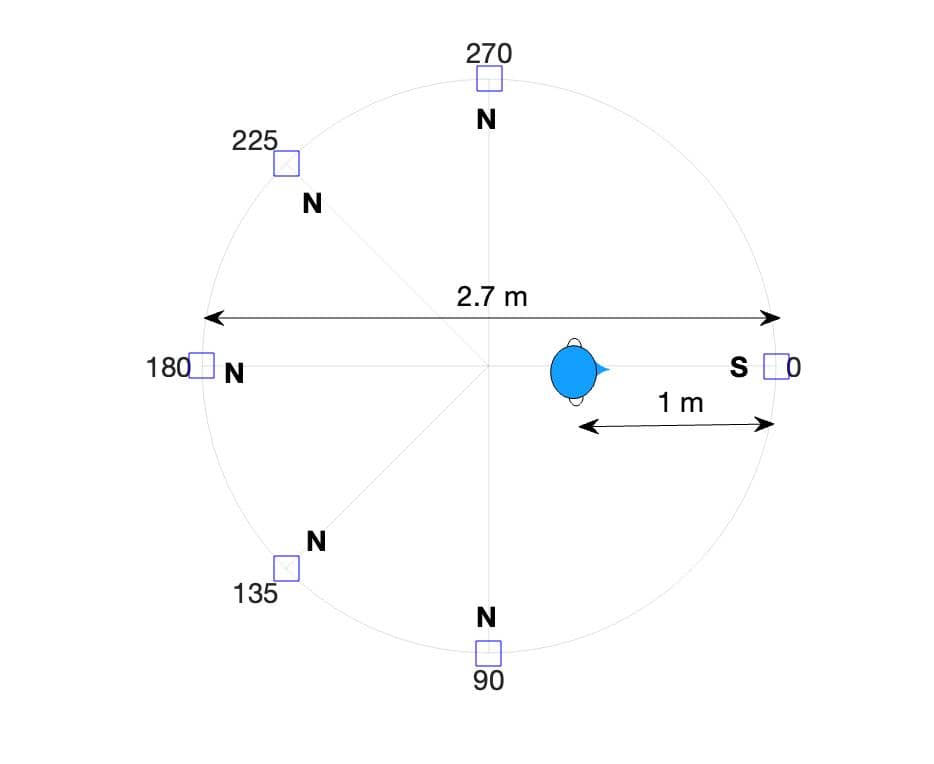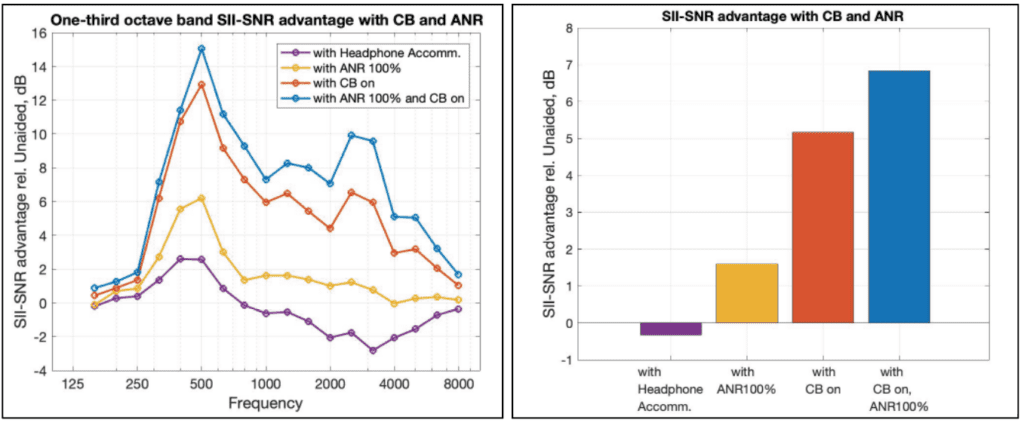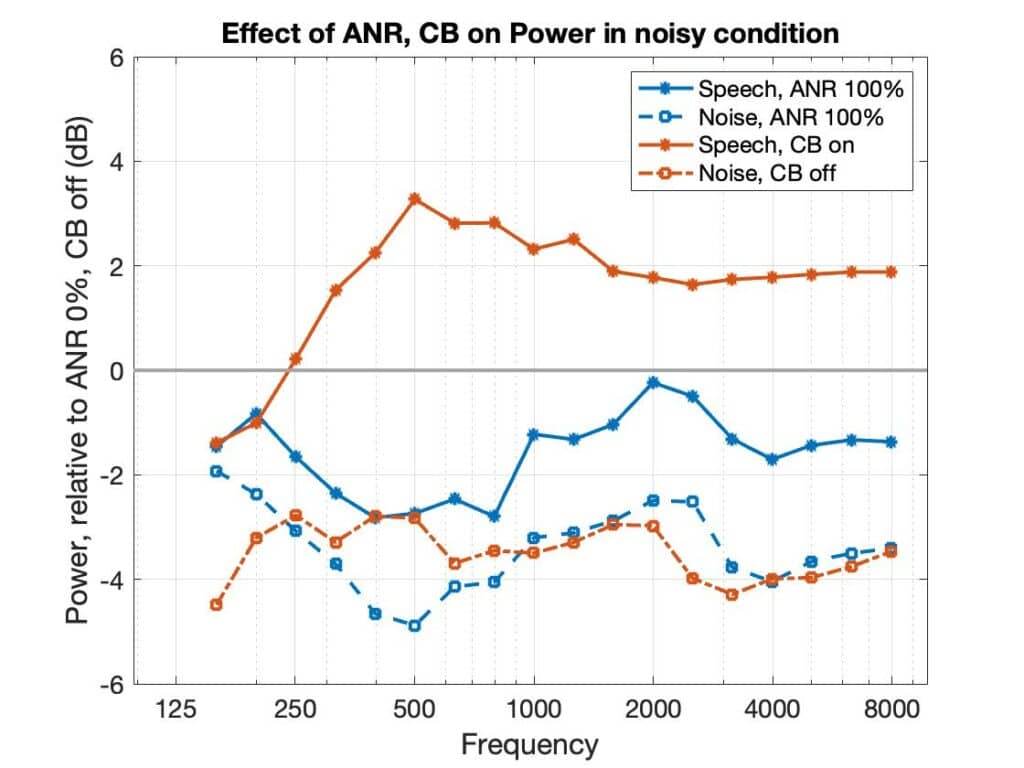Tech Topic | April 2022 Hearing Review
How effective are the Conversation Boost (CB) and Ambient Noise Reduction (ANR) features in the extremely popular Apple Airpods Pro? Research at the National Acoustic Laboratories (NAL) show an improvement in SII-weighted SNR of around 7 dB for a talker located in front of the listener in a noisy environment for the CB-on and ANR-100% condition. Conversation Boost, which uses beamforming and smart audio processing, produced most of this directional benefit.
By Nicky Chong-White, PhD, Jorge Mejia, PhD, Joaquin T. Valderrama-Valenzuela, PhD, and Brent Edwards, PhD
Integration of health-related capabilities in smartphones and consumer earbuds is growing, with new technology features continuously emerging to benefit people with hearing difficulties. Our previous evaluation of Apple AirPods Pro as hearing devices (see the December 2021 edition of The Hearing Review) investigated the performance of the Headphone Accommodations feature that, when used in Transparency mode, amplifies sounds around the listener based on their hearing needs.1 Headphone Accommodations provides personalized frequency-specific, level-dependent gain to make soft sounds audible in quiet environments for people with mild-to-moderate hearing loss without making loud sounds uncomfortable.
While this feature can provide hearing help in quiet, people with hearing loss also have increased difficulty understanding speech in noisy situations. This may cause them to avoid difficult listening situations and can lead to social isolation and reduced quality of life. Use of directional microphones in hearing aids has proven effective at improving the signal-to-noise ratio (SNR), and hence speech intelligibility, by picking up sounds coming from in front of the listener while attenuating sounds from other directions.2
With iOS 15, Apple has introduced two additional accessibility features for AirPods Pro—Conversation Boost and Ambient Noise Reduction—to further help people with hearing loss. Conversation Boost is designed to use computational audio and beamforming microphones to help the wearer focus on the voice of the person in front of them in noisy environments.3 Ambient Noise Reduction allows the user to adjust the amount of background noise they can hear when wearing AirPods Pro in Transparency mode.
The focus of this study was to perform objective measurements with AirPods Pro in a noisy environment to provide insights into how these earbuds may improve speech understanding, listening effort, and listening comfort for people with hearing loss in background noise.
Methods
The acoustic measurements were conducted in a laboratory test room with loudspeakers at approximate ear level in a horizontal circular array of diameter 2.7 m. A moderately-challenging noise environment was produced with five noise sources located to the sides and behind the listener, as shown in Figure 1. Multi-talker continuous babble noise was presented uncorrelated from loudspeakers at positions ±90°, ±135°, and 180° azimuth. Target speech was presented from the loudspeaker at 0° azimuth. The speech material used was BKB-like sentences spoken in English by a male talker. The background noise and target speech were simultaneously presented from the loudspeakers. The noise was calibrated to 65 dB SPL at the position of the listener using a free-field microphone, and the SNR was set to -3 dB, a common SNR level of cafes and restaurants where communication is challenging.

Apple AirPods Pro earbuds (with firmware version 4A402) paired with an iPhone running iOS 15.1 were worn by an adult participant, and a good seal with the ear canal was maintained throughout the entire measurement session. The participant was seated within the array, facing the loudspeaker at 0° azimuth, at a distance of 1 m. Probe microphone tubes were inserted in the participant’s ears to record the output of the AirPods Pro near the eardrum. The AirPods Pro were set to Transparency Mode with Headphone Accommodations.
Procedure
To estimate the SNR at the eardrum, an inversion technique was used.4 Two successive recordings were made with the same speech and noise stimuli; however, in the second recording, the phase of the speech stimulus was inverted. During post-processing, the two recordings were summed and subtracted to separate the target speech and noise components and thus estimate the SNR.
The extracted target speech and noise signals were passed through a one-third octave filter bank, and the SNR and SNR advantage (the difference between SNR of the test condition over a reference condition) was determined in each frequency band. To relate the SNR to speech intelligibility, band importance weights based on the speech intelligibility index (SII, ANSI S3.5–1997) were applied. The SII-weighted dB SNR advantage values were averaged to give a single index which we will refer to as the SII-SNR advantage.
Test conditions included four combinations of Conversation Boost (CB) on/off and Ambient Noise Reduction (ANR) 0%/100%, allowing for analysis of the effect of CB-on only, the effect of ANR at 100% only, and the effect of activating both. Measurements were performed with three preset hearing loss profiles available in iOS (Balanced Tone, Vocal Range, and Brightness) and two custom audiograms (Flat 40 dB HL and Mild-to-moderate downward sloping hearing loss).
Results
SII-SNR advantage. The SII-SNR advantage due to Conversation Boost and Ambient Noise reduction is shown in Table 1. Most notably, turning on CB produced 4.3-5.5 dB SII-SNR advantage. Increasing ANR from 0% to 100% produced around 2 dB SNR advantage. With both features fully activated, the effects added to give up to 7.2 dB SII-SNR advantage. The values varied slightly across the different hearing loss profiles, likely due to the differences in Headphone Accommodations gain for frequencies that are important for speech intelligibility. The SNR advantage was generally smaller when amplification was less (ie, for milder hearing losses).

The SII-SNR advantage of AirPods Pro over the unaided condition is plotted in Figure 2. For the Balanced Tone preset, the AirPods Pro with both CB-on and ANR-100% gives an SII-SNR advantage of almost 7 dB compared to not wearing any devices at all. The effect on SNR of Headphone Accommodations (without CB or ANR activated) is also displayed; however, while Headphone Accommodations improves audibility of speech and other sounds, it is ineffective at improving SNR without directionality.

Background noise reduction. In addition to a slight SII-SNR improvement, the Ambient Noise Reduction feature of AirPods Pro has the main noticeable effect of reducing the overall level when background noise is detected. This aims to improve listening comfort. The power of the speech and noise signals at the eardrum with ANR-100% and CB-on, relative to ANR-0% and CB-off, are shown in Figure 3. As shown by the negative traces, increasing ANR has the effect of reducing the level of both the target speech and noise signals. By comparison, turning CB on reduced the level of the noise, but increased the level of the target speech.

CB and ANR Are Effective Features
Objective measurements of Conversation Boost and Ambient Noise Reduction features of AirPods Pro showed an improvement in SII-weighted SNR of around 7 dB for a talker located in front of the listener in a noisy environment. Conversation Boost, which uses beamforming and smart audio processing, produced most of the directional benefit. This SNR advantage can be compared to hearing aids with conventional directional microphones that provide 3-6 dB SNR improvement.5 The increase in the SNR is expected to improve speech understanding in background noise for hearing-impaired listeners. Note that since noise was only presented from the side and rear of the listener, the SNR improvement is expected to be less when the noise is diffuse or all around the listener. The Ambient Noise Reduction feature gave a slight increase in SNR and additionally reduced the overall signal level which should improve listening comfort.
The benefits of AirPods Pro for people with normal audiograms but self-reported hearing difficulties in noise was investigated in a recent study at NAL through a collection of questionnaires, laboratory tests, and real-life benefit measures. Consistent with the findings of this report, speech-in-noise testing showed that AirPods Pro in Conversation Boost mode increased speech intelligibility scores systematically across participants compared to when no devices were worn.
With these hearing aid-like features, AirPods Pro have the potential to help some people with hearing loss understand and communicate during conversations. Other factors to consider include sound quality, performance in different types of challenging environments, comfort, hours of available use while in these modes, severity of hearing loss, and willingness of people to wear the earbuds to improve their hearing during their everyday life.
References
- Chong-White N, Mejia J, Galloway J, Edwards B. Evaluating Apple AirPods Pro with Headphone Accommodations as hearing devices. Hearing Review. 2021;28(12)8-11.
- Dillon H. Hearing Aids. 2nd ed. New York City:Thieme; 2012
- Apple Corp. Apple Hearing accessibility features. Available at: https://www.apple.com/au/accessibility/hearing/
- Hagerman B, Olofsson Å. A method to measure the effect of noise reduction algorithms using simultaneous speech and noise. Acta Acustica United with Acustica. 2004;90(2):356-361.
- Ricketts TA. Directional hearing aids. Trends Amplif. 2001;5(4):139-176.
CORRESPONDENCE can be addressed to Dr Chong-White at: [email protected]







Are these air pods better than a normal hearing aid..?
No, they are not, mainly because the professional care element (eg, assistance from an audiologist or hearing aid specialist) is not included. However, they can be very helpful for people with a milder hearing loss for situational uses. One of the key problems for these devices as a longer-term solution is that you won’t be able to get much more than 3-4 hours out of them. It also really depends on the severity and type of hearing loss you have. However, the Airpods Pro are so prevalent (and they’re great earbuds for listening to streamed sound) that it’s exciting to have them incorporating these types of features.